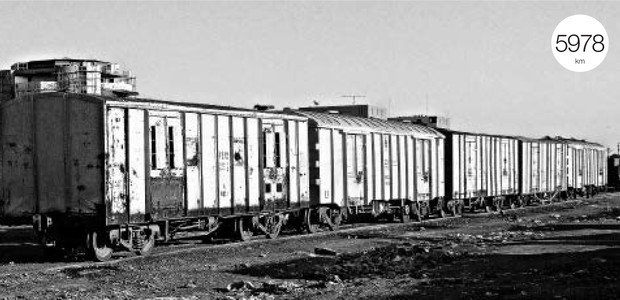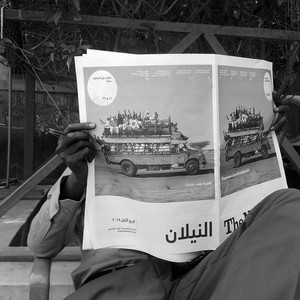A ticket to nowhere

> Departure: -
> Arrival: -
> Distance: 5,978km
In its heyday, Sudan’s railway measured about 4,588km, with four main train lines crossing the country. But a sharp decline began in the 1990s, and has continued ever since.
Today, only the northern line to Atbarah carries passengers while the others are largely derelict, sometimes merely lines of scrap metal tossed on roadsides, and there is scant evidence of a return to the golden years.
A legacy of British rule in Sudan, the railway cost around half a million British pounds (US$757,500), according to the English writer Mark Estrag in his book ‘From Cape to Cairo’. Lord Kitchener, the British campaign’s leader, ordered the railways to be built mainly to “transport supplies and food to the army when it passes through Sudan”, Estrag wrote.
The railways were built by Egyptian farmers, Sudanese people, and 200 prisoners who were released especially to help the construction, as well as a number of soldiers. Key to the railway development was a Canadian engineer, Sir Édouard Percy Cranwill Girouard, who helped establish the Canadian Pacific Railways before joining the British army.
Opened on the last day of the 19th century, the railway line initially spanned some 1,068km between Halfa in the north of Sudan and Khartoum-Bahri, a link used mainly for military purposes.
The line was expanded to the east of the country in 1905 and was connected to Port Sudan on the Red Sea. In 1909 the railways were developed to reach towards Al Jazirah, linking to the largest agricultural project in the country, and thus boosting the economy. In 1912, tracks reached into the White Nile in western Sudan.
By the time Sudan gained self-rule in 1954, its railway network had expanded to 3,104km, according to Mustafa Mohamed Khojali in an article written in English and published in Sudan Studies Magazine in July 2010. The post-independence national government increased this network “to consolidate national unity and strengthen economic development”, he wrote.
It built three railways: a short one from Sennar to Damazin and two longer ones from Arabeida to Nyala in Darfur and from Babanousa to Wau in Ghazal Sea, reaching a total length of 4,588km.
Journalist Qurashi Awad praised the railways for “connecting all parts of Sudan with each other”, underlining that they had a big impact on public life as “they developed the countryside and contributed to establishing cultural clubs, cooperatives, and schools”.
Salah Khalifa, a Sudan Railway Cooperation (SRC) worker for more than 20 years, underlined the social impact of the railway. “Uniting Sudan and linking all the Sudanese tribes with their cultures” was the railways’ most important achievement, said Khalifa, who comes from the north. He added that the railways connected him to people from Babanousa, the east and the centre. “I was introduced to many cultures.”
Trains offered citizens a cheap and secure means of transport, a step up from travelling by road on the back of lorries. In recent years, the roads have been paved and the railways have decayed so people tend to travel by cars and coaches. The railway’s decline follows years of negligence, poor management, and political problems.
Its deterioration began in the late 1970s. Khalifa believes the government of Jaafar Nimeiry (1969-1985) was to blame for the downturn. “Workers’ strikes were a major concern for the government and, thus, the body they belonged to had to be finished.”
Successive governments followed the same strategy, he said, igniting an era of confrontation between politicians and railways workers’ unions. Thousands of experienced workers and engineers were sacked during this time.
Meanwhile, economic boycotts suddenly meant that spare parts were in short supply. The Sudan Railways Corporation was hurt by a lack of regular maintenance and the US sanctions, as more than 80 percent of the railway’s machines were made in America.
The restoration of the railway is often discussed by the government and the Sudan Railways Corporation but their words have yet to be turned into action. Recent attempts include the government’s plan to improve the link between Khartoum and the neighbouring states, a scheme unveiled by officials in October. But as yet no details have been provided.
Abdullah Ali Masar, chairman of the Transport Committee in the National Council has said that projects to develop the transport sector will soon reach neighbouring countries with a plan “to establish two railway lines to Ethiopia and Chad”.
Many view the renewal of the Sudanese railways as a key priority for the nation. “Rebuilding the Sudanese railways is connected to rebuilding Sudan as a country,” journalist Awad said.
He added that reviving the railways will require “developing technical education, training staff in specialised schools and, most important of all, changing the country’s external policies through cooperating with countries in the field of developing railways to import spare parts”.
Khalifa agreed with him, saying the network needs “full maintenance of trains and the neglected railways... Experts, engineers, and fast trains should be imported.” In light of Sudan’s deep economic malaise and a lack of political action, however, the railways look set to stand derelict for some time.




